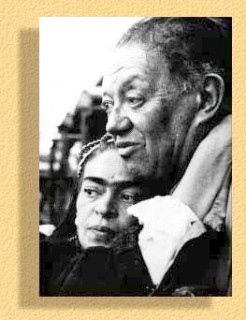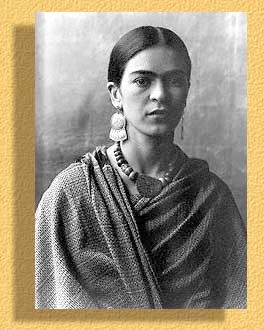
Frida Kahlo Fans
Brief Biography

 |
Frida Kahlo FansBrief Biography
|
 |
|
Frida Kahlo was born
Magdalena Carmen Frida Kahlo y Calderon in Coyoacan, Mexico, July 6th,
1907. She was one of four daughters born to a Hungarian-Jewish father
and a mother of Spanish and Mexican Indian
descent. FRIDA did not originally plan to become an artist. A survivor
of polio, she entered a pre-med program in Mexico City. At the age of
18, she was seriously injured in a bus accident. She spent over a year
in bed recovering from fractures to her spine, collarbone and ribs, a
shattered pelvis, and shoulder and foot injuries. She endured more than
30 operations in her lifetime and during her convalescence she began to
paint. Her paintings, mostly self-portraits and still life, were deliberately
naïve, and filled with the colors and forms of Mexican folk art.
At 22 Frida married the famous Mexican muralist Diego
Rivera, 20 years her senior. Their stormy, passionate relationship
survived infidelities, the pressures of careers, divorce, remarriage,
Frida's bi-sexual affairs, her poor health and her inability to have children.
Frida once said: "I suffered two grave accidents in my life…One
in which a streetcar knocked me down and the other was Diego."
The streetcar accident
left her crippled physically and Rivera crippled her emotionally. Both Frida and Diego
were very active in the Communist Party in Mexico. In early July 1954,
Frida made her last public appearance, when she participated in a Communist
street demonstration. Soon after, on July 13th, 1954, at the age of 47,
Frida passed away. Her ashes were placed in a pre-Columbian urn which is on display in the "Blue House" that she shared with Rivera. One year after her death, Rivera gave the house to the Mexican government to become a museum. Diego Rivera died in 1957. On July 12th, 1958, the “Blue House” was officially opened as the “Museo Frida Kahlo”. Frida has been described as: "…one of history's grand divas…a tequila-slamming, dirty joke-telling smoker, bi-sexual that hobbled about her bohemian barrio in lavish indigenous dress and threw festive dinner parties for the likes of Leon Trotsky, poet Pablo Neruda, Nelson Rockefeller, and her on-again, off-again husband, muralist Diego Rivera." Today, more than half a century after her death, her paintings fetch more money than any other female artist. A visit to the Museo Frida Kahlo is like taking a step back in time. All of her personal affects are displayed throughout the house and everything seems to be just as she left it. One gets the feeling that she still lives there but has just briefly stepped out to allow you to tour her private sanctuary. She is gone now but her legacy will live on forever…. "Larga
Vida a Nuestra Frida" |
||||